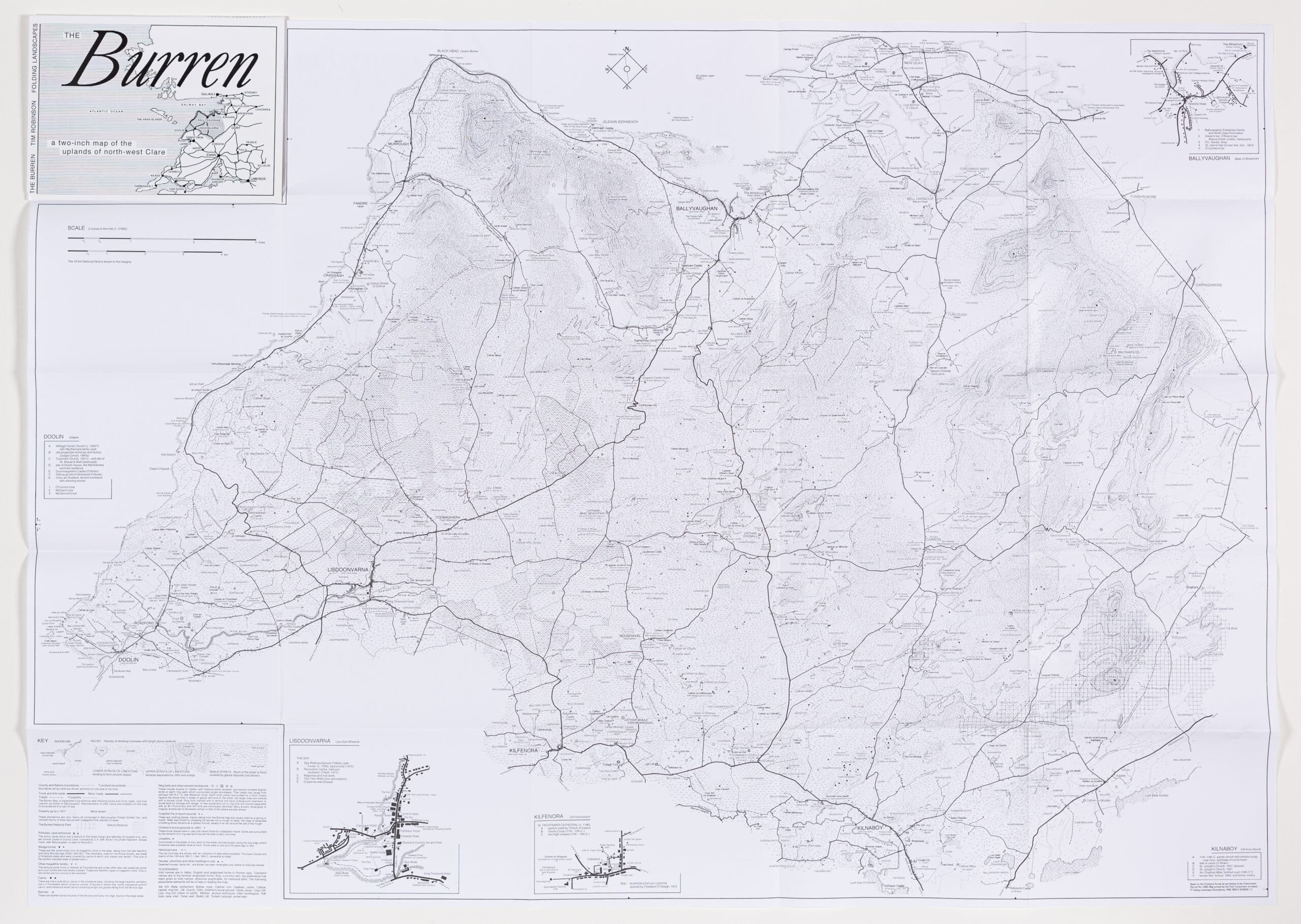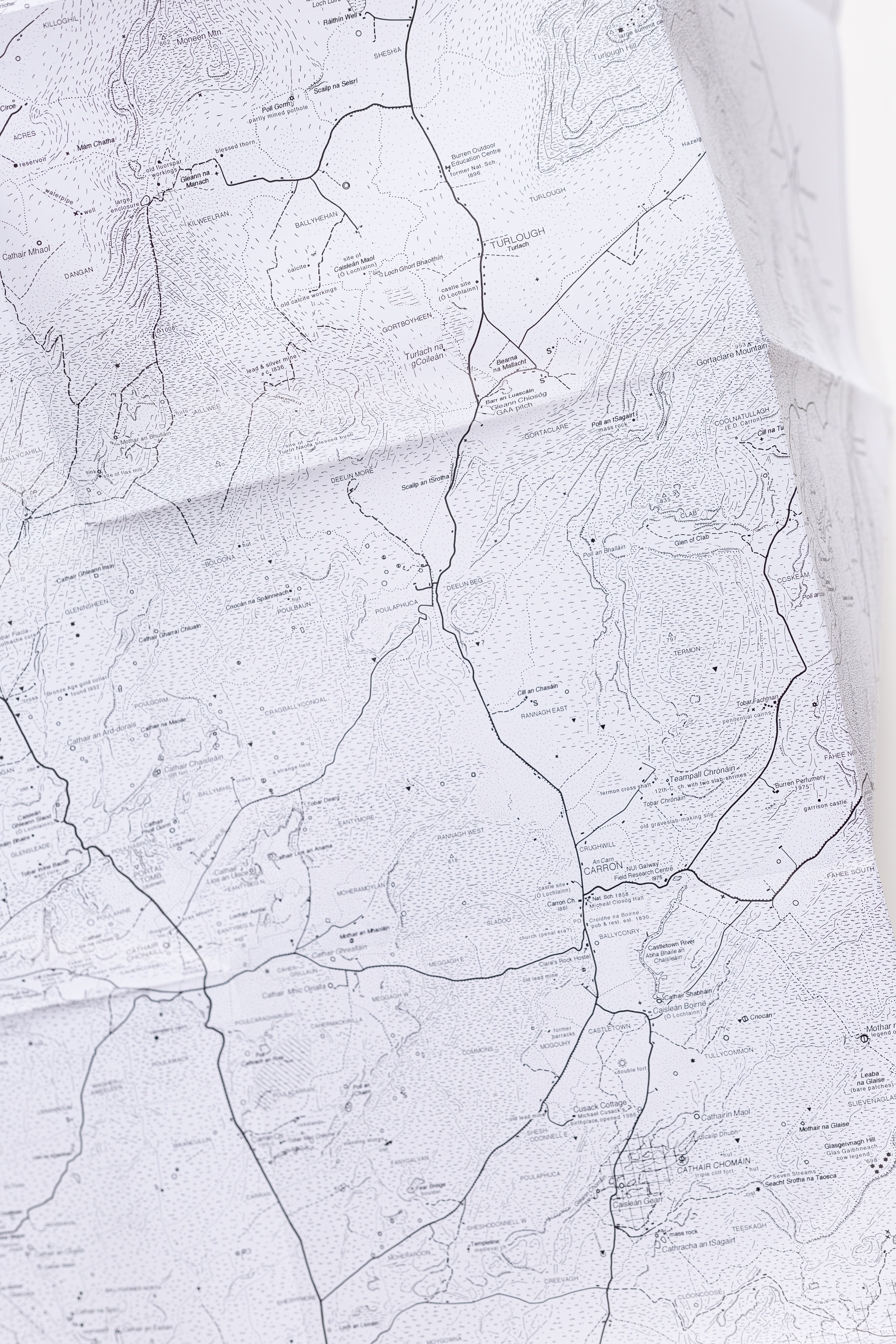Tim Robinson: Deep Mapping
This text is an excerpt from Shallow Time: The Burren (Dpr-Barcelona and Irish Architecture Foundation, 2023), 73-74, written by Tom Cookson. The text is reproduced with permission from the Irish Architecture Foundation.

How to communicate the topographic nature of landscape and lived experience on a map reproduced on paper? The composition of cartography offers similar challenges to those faced when interpreting the work of the Abstract Expressionists. Maps have no consistent vanishing point, they are ‘not a Renaissance image which can be easily understood like a photograph, the eye is forced to roam, attention is required’.[1] Neither are they a Western text that can be read from left to right, top to bottom. Robinson asks us to accept this challenge and embrace it. He prepares us for this in the name, ‘Folding Landscapes’. The act of revealing the map, unfolding it, transforms the surface into human action, it accords the flatness form. The planes converse, enclosing and framing dynamic shifting space as the map is unfurled, a version of the topographies they interpret, a shadow of their reality. Yet we each engage with this reality in different ways. The map is a version of the landscape, which is then interpreted individually. It is inert and takes on a life through our personal fusion between it and the landscape it reflects.


Yet mapping the Burren began with control and empire. The original Ordnance Survey maps completed by the British military between 1824 and 1846 were intrinsic to the colonialist project.[2] Ireland was mapped to appropriate and legalise the settings of rents and rates, land and leases. Ultimately, to allow Parliament to accurately tax landowners.[3] In this process, a measure of multivalent subjugation was exacted over the Irish language, with the anglicisation of placenames becoming formalised not only through OS maps, but also in the reams of legal documents which followed, thereby imposing a subsidiary layer of control over the land. Robinson’s practice used these maps as a framework, but his aims were naturally very different. He was pursuing a form of mapping ‘that will be faithful to more than the measurable’.[4] Continually questioning what is worthy of measure, each mark he made agonised and precious.[5] We must not forget that Robinson was a successful London artist—under the name of Timothy Drever—before he relocated with his wife Máiréad to Aran. It was this artist’s sensibility that he transferred to cartography. He was also part of the modernist tradition in this early work, as evidenced by his Moonfield exhibition at the Camden Arts Centre in 1969.

His maps were hand drawn, traced over the Ordnance Survey originals. Yet always with a sense that the hand drawn would be reproduced, an individuality resides amongst the reproduction, a contradiction delicately negotiated.[6] But the drawing was very much the last step in a process. Preceding this were countless miles of walking the landscape, of observation, of cognition. Most importantly, talking to people with embedded experience of the environments he interpreted. He was transcribing a fading oral culture, from step, to brain, to hand. The maps becoming repositories for both information and experience, cultural manuscripts.[7]
Tom Cookson is an architect, writer and educator. He is interested in the intersection between architecture and environment in the context of the Anthropocene.
Shallow Time: The Burren is supported by the Irish Architecture Foundation’s LINA Writing Award 2022, in collaboration with dpr-barcelona. The LINA Architecture Platform is funded by Creative Europe.
Irish Architecture Foundation (About): About – Irish Architecture Foundation
Irish Architecture Foundation (Writing Award): Announcing the LINA Writing Award recipients – Irish Architecture Foundation
DPR Barcelona: https://dpr-barcelona.com/about-us/
LINA Architecture Platform (About): Who we are • LINA
Shallow Time: The Burren can be purchased online from The Library Project: Shallow Time: The Burren, Tom Cookson – The Library Project
Notes
- Jenny Odell, How to Do Nothing: Resisting the Attention Economy (London: Suite 2000), 99.
- Derek Gladwin & Christine Cusick, Unfolding Irish Landscapes: Tim Robinson, Culture, and Environment (Manchester: Manchester University Press), 218.
- Brian Dillon, ‘An Interview with Tim Robinson’ Field Day Review 3. (2007), 38.
- Gladwin & Cusick, Op. cit., 200.
- Gladwin & Cusick, 204.
- Gladwin & Cusick,199.
- Dillon, Op. cit., 38.
